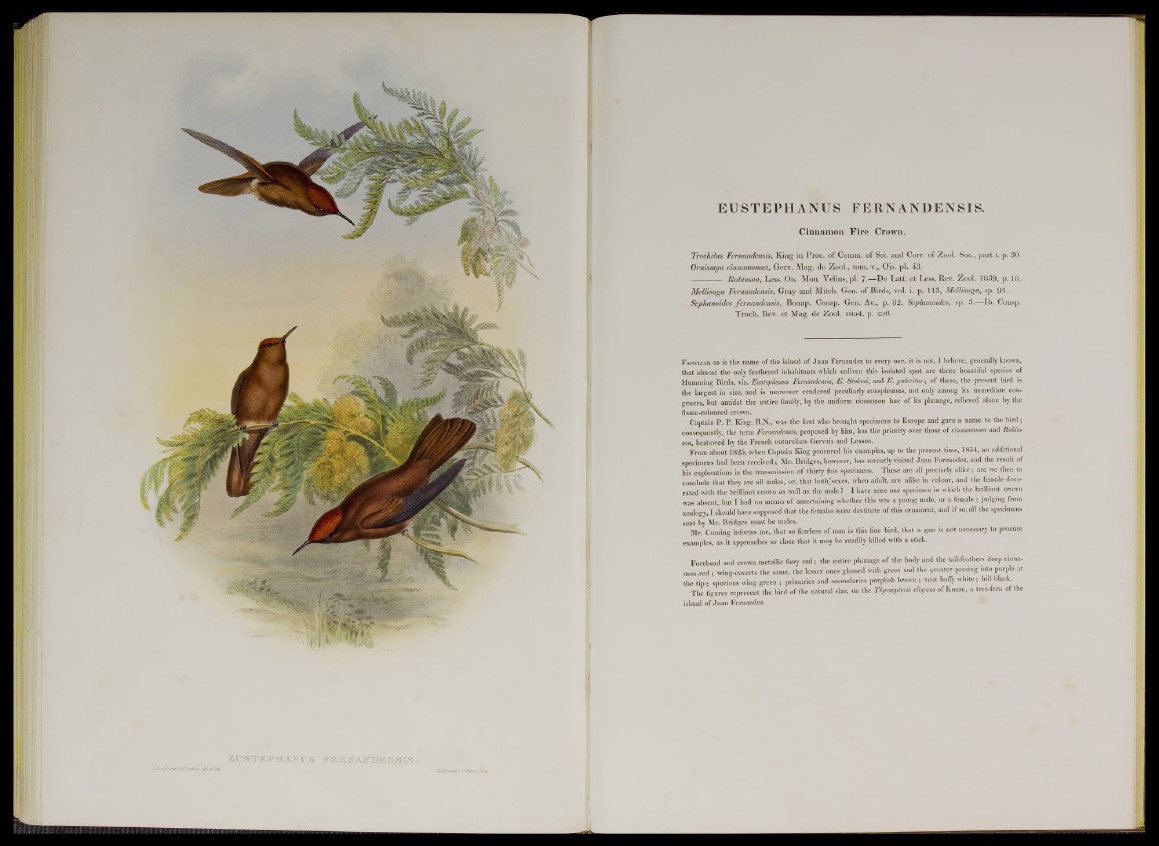
EU ST E PHANUS FERN AN DEN SI S.
Cinnamon Fire Crown.
Trochilus Fernandensis, Kin g in Proc. o f Comm, o f Sci. and Corr. o f Zool. Soc., p a rt i. p. 30.
Ornismya cinnamomea, Gerv. Mag. de Zool., tom. v., Ois. pi. 43.
— :-------- Robinson, Less. Ois. Mou. V elin s,p l. 7-— D e Latt. e t Less. Rev. Zool. 1839, p. 18.
Mellisuga Fernandensis, G ray and Mitch. Gen. o f Birds, vol. i. p. 113, Mellisuga, sp. 95.
Sephanoides fernandensis, Bonap. Consp. Gen. Av., p. 82, Sephanoides, sp. 3.—lb . Consp.
T ro ch . Rev. e t Mag. de Zool. 1854, p. 256.
F amiliar as is the name of the island of Juan Fernandez to every one, it is not, I believe, generally known,
that almost the only feathered inhabitants which enliven this isolated spot are three beautiful species of
Humming Birds, viz. Eustephanus Fernandensis, E. Stokesi, and E. galeritus; of these, the present bird is
the largest in size, and is moreover rendered peculiarly conspicuous, not only among its immediate congeners,
but amidst the entire family, by the uniform cinnamon hue of its plumage, relieved alone by the
flame-coloured crown.
Captain P. P. King, R.N., was the first who brought specimens to Europe and gave a name to the bird ;
consequently, the term Fernandensis, proposed by him, has the priority over those of cinnamomea and Robinson,
bestowed by the French naturalists Gervais and Lesson.
From about 1825, when Captain King procured his examples, up to the present time, 1854, no additional
specimens had been received; Mr. Bridges, however, has recently visited Juan Fernandez, and the result of
his explorations is the transmission of thirty fine specimens. These are all precisely alike; are we then to
conclude that they are all males, or, that both'sexes, when adult, are alike in colour, and the female decorated
with the brilliant crown as well as the male ? I have seen one specimen in which the brilliant crown
was absent, but I had no means of ascertaining whether this was a young male, or a female ; judging from
analogy, I should have supposed that the females were destitute of this ornament, and if so, all the specimens
sent by Mr. Bridges must be males.
Mr. Cuming informs me, that so fearless of man is this fine bird, that a gun is not necessary to procure
examples, as it approaches so close that it may be readily killed with a stick.
Forehead and crown metallic fiery red ; the entire plumage of the body and the tail-feathers deep cinnamon
red ; wing-coverts the same, the lesser ones glossed with green and the greater passing into purple at
the tip ; spurious wing green ; primaries and secondaries purplish brown ; vent buffy white; bill black.
The figures represent the bird of the natural size, on the Thyrsopteris elegans of Kunze, a tree-fern of the
island of Juan Fernandez.